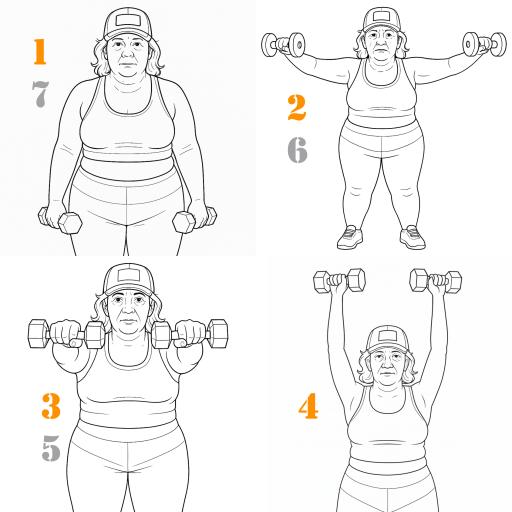Compound Dumbbell Raise Exercise
A Multi-Plane Dumbbell Movement for Balanced Shoulder Development

Compound Dumbbell Raise Exercise
The Compound Dumbbell Raise is a full-range shoulder mobility and strength movement that challenges your deltoids, traps, and upper chest through multiple planes of motion. It combines elements of the lateral raise, front raise, and overhead press into a controlled, fluid sequence.
Movement Sequence:
1. Start Position: Stand tall with a dumbbell in each hand, arms at your sides, palms facing your body (neutral grip). Feet shoulder-width apart, core braced.
2. Lateral Raise: Raise your arms straight out to your sides until they are level with your shoulders, palms now facing the ground (pronated grip). Keep arms fully extended and avoid shrugging.
3. Front Transfer: From the T-position, bring your arms forward in a wide arc until both dumbbells are directly in front of your shoulders, still fully extended and parallel to the floor.
4. Overhead Raise: Without bending your elbows, raise the dumbbells straight overhead until your arms are in line with your ears. Palms remain facing forward. Keep your spine neutral and avoid arching your back.
5. Return to Front: Lower your arms back down to the front shoulder-height position, fully extended, palms down.
6. Lateral Transfer: Move your arms outward from the front position back to the T-position (shoulder level, out to the sides), keeping the same arm alignment and control.
7. Lower to Start: Finally, bring your arms back down to your sides with palms facing your body, returning to the original starting position.
Muscles Worked:
* Deltoids (All Heads): Lateral, anterior, and posterior delts are activated through various raise angles.
* Upper Trapezius: Stabilizes and lifts during the lateral and overhead phases.
* Serratus Anterior: Helps control overhead movement and scapular motion.
* Rotator Cuff: Engaged throughout to stabilize the shoulder joint.
* Pectoralis Major (Upper Chest): Especially during front and overhead phases.
* Core & Postural Muscles: Engaged isometrically to maintain spinal alignment and balance.
Benefits:
* Shoulder Strength and Endurance: This sequence trains the shoulder through its full range, building strength in multiple directions.
* Improved Motor Control: Requires deliberate movement transitions, teaching control and coordination.
* Injury Prevention: Strengthens stabilizers and supports joint health when performed with proper form and moderate weight.
* Time-Efficient: Multiple planes of movement in one set make this a compound activation tool — ideal for warmups or burnout rounds.
Tips:
* Use light to moderate weight — form is more important than load.
* Perform slow and controlled reps; don’t swing or use momentum.
* Keep a slight bend in the knees and brace your core throughout.
* Avoid shrugging or over-arching your back during the overhead phase.
Recommended Use:
2–3 sets of 6–10 controlled reps per set. Works well in shoulder circuits or upper-body conditioning routines.
The Compound Dumbbell Raise is a full-range shoulder mobility and strength movement that challenges your deltoids, traps, and upper chest through multiple planes of motion. It combines elements of the lateral raise, front raise, and overhead press into a controlled, fluid sequence.
Movement Sequence:
1. Start Position: Stand tall with a dumbbell in each hand, arms at your sides, palms facing your body (neutral grip). Feet shoulder-width apart, core braced.
2. Lateral Raise: Raise your arms straight out to your sides until they are level with your shoulders, palms now facing the ground (pronated grip). Keep arms fully extended and avoid shrugging.
3. Front Transfer: From the T-position, bring your arms forward in a wide arc until both dumbbells are directly in front of your shoulders, still fully extended and parallel to the floor.
4. Overhead Raise: Without bending your elbows, raise the dumbbells straight overhead until your arms are in line with your ears. Palms remain facing forward. Keep your spine neutral and avoid arching your back.
5. Return to Front: Lower your arms back down to the front shoulder-height position, fully extended, palms down.
6. Lateral Transfer: Move your arms outward from the front position back to the T-position (shoulder level, out to the sides), keeping the same arm alignment and control.
7. Lower to Start: Finally, bring your arms back down to your sides with palms facing your body, returning to the original starting position.
Muscles Worked:
* Deltoids (All Heads): Lateral, anterior, and posterior delts are activated through various raise angles.
* Upper Trapezius: Stabilizes and lifts during the lateral and overhead phases.
* Serratus Anterior: Helps control overhead movement and scapular motion.
* Rotator Cuff: Engaged throughout to stabilize the shoulder joint.
* Pectoralis Major (Upper Chest): Especially during front and overhead phases.
* Core & Postural Muscles: Engaged isometrically to maintain spinal alignment and balance.
Benefits:
* Shoulder Strength and Endurance: This sequence trains the shoulder through its full range, building strength in multiple directions.
* Improved Motor Control: Requires deliberate movement transitions, teaching control and coordination.
* Injury Prevention: Strengthens stabilizers and supports joint health when performed with proper form and moderate weight.
* Time-Efficient: Multiple planes of movement in one set make this a compound activation tool — ideal for warmups or burnout rounds.
Tips:
* Use light to moderate weight — form is more important than load.
* Perform slow and controlled reps; don’t swing or use momentum.
* Keep a slight bend in the knees and brace your core throughout.
* Avoid shrugging or over-arching your back during the overhead phase.
Recommended Use:
2–3 sets of 6–10 controlled reps per set. Works well in shoulder circuits or upper-body conditioning routines.
Updated: August 13, 2025 10:19
Category: Exercises
Keywords: exercises shoulders upper back arms
Comments
You must log in to post a comment.